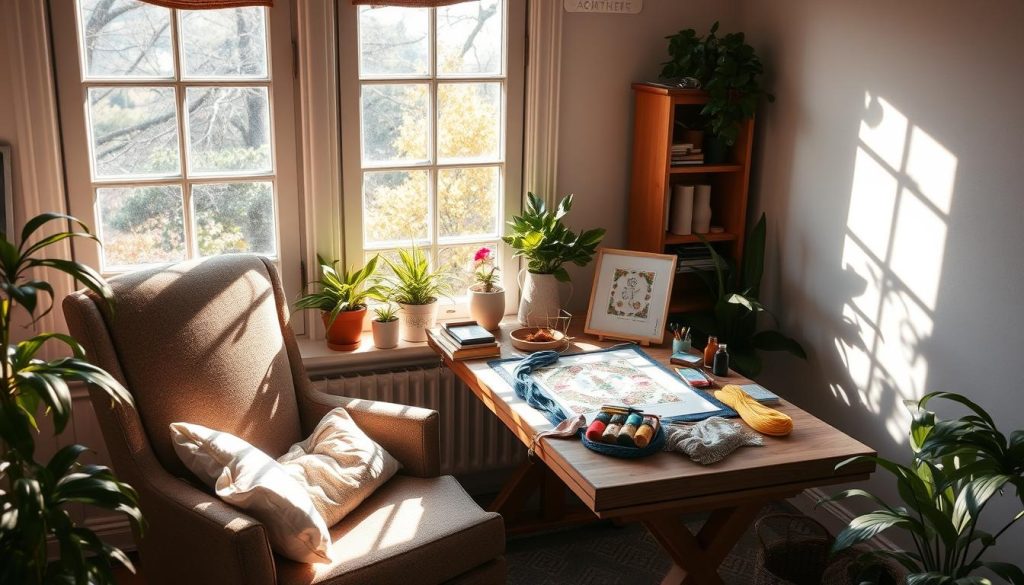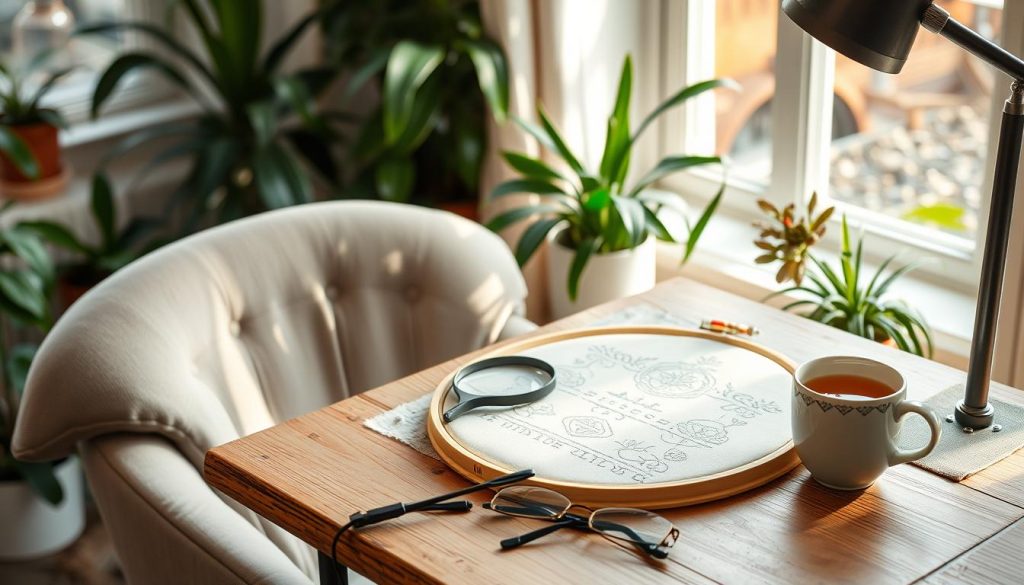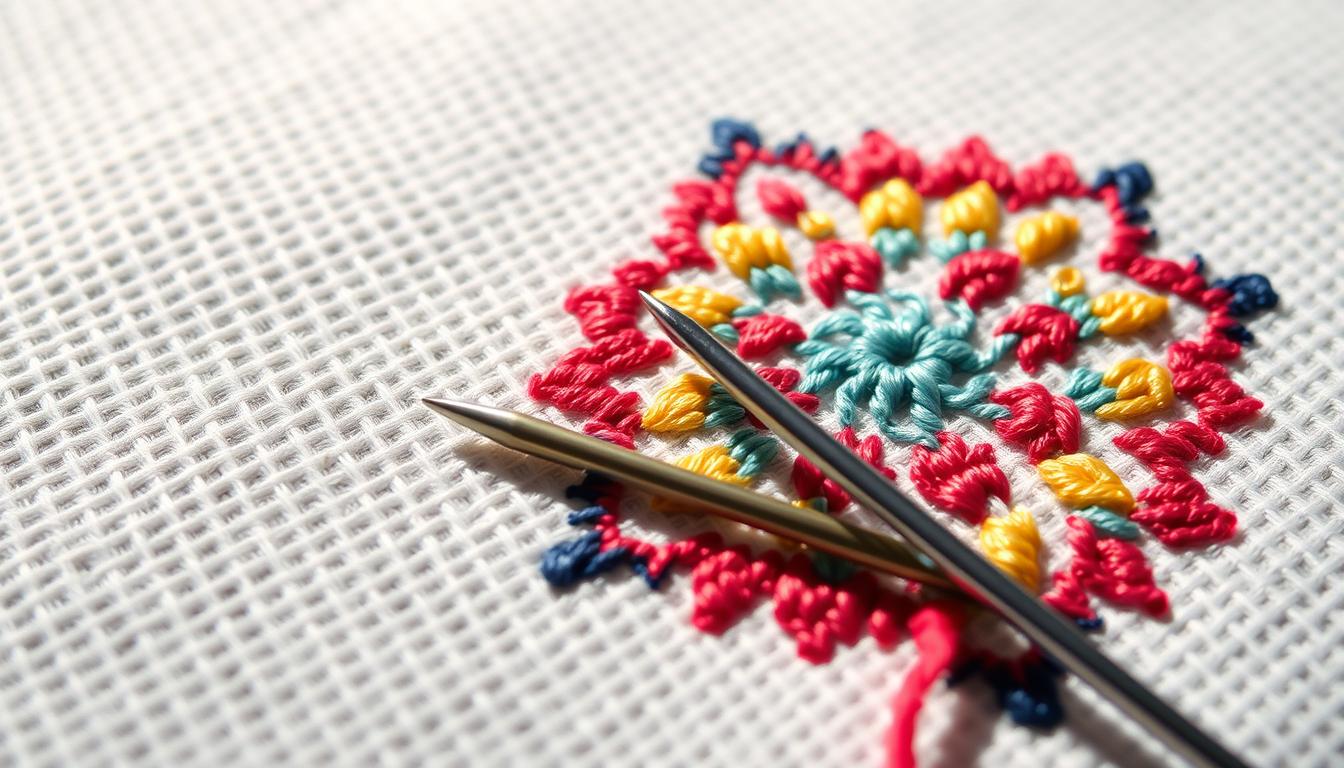Many cross stitch fans worry if their hobby could harm their eyes. Surveys show that vision problems are a big reason people stop stitching. Some even see their vision get worse, making them give up their hobby.
To ease concerns about eye strain from cross stitch and vision issues, hobbyists need to take steps. Opticians suggest wearing glasses while cross-stitching, especially if you need them. Also, good lighting and breaks are key to stitching safely and comfortably.
Key Takeaways
- Vision impairment is a leading reason why many individuals stop cross-stitching.
- Opticians recommend using glasses to minimize eye strain while working on cross stitch patterns.
- Adequate lighting conditions, including natural light and table lamps, are crucial in preventing eye strain.
- Optometrists advise following the 20-20-20 rule for taking breaks to avoid eye fatigue.
- Diversifying your hobbies helps in maintaining prolonged eye health.
- Regular eye tests are essential for those frequently involved in close work like cross-stitching.
The Impact of Cross Stitch on Vision
Doing cross stitch for a long time can hurt your eyes. If you don’t take breaks, you might see problems that make stitching hard.
Understanding Eye Strain
Many stitchers get eye strain. It feels like your eyes are sore, tired, and blurry. You might also get headaches. This happens when you stare at cross stitch kits too long without taking a break.
To avoid eye strain, get your eyes checked often. Your optician will tell you if you need glasses. They also suggest using protective gear to keep your eyes safe.
Common Vision Issues Among Stitchers
Stitching can cause several vision problems:
- Astigmatism and near-sightedness get worse if the light is not right.
- Magnifying glasses help you stitch better, especially if they’re attached to your table.
- The type of fabric you use, like 14 count Aida, can make things clearer or harder to see.
| Vision Issue | Cause | Solution |
|---|---|---|
| Astigmatism | Inadequate lighting | Use proper lighting and magnifiers |
| Near-sightedness | Prolonged stitching | Frequent breaks and correct prescription glasses |
| Eye Strain | Focusing on intricate designs | Use magnifying glasses and proper lighting |
With the right tools, you can enjoy cross stitch without eye problems. Good lighting and magnifiers make stitching easier and more fun.
Importance of Proper Lighting
Good lighting is key when you’re working on cross stitch projects. It helps prevent eye strain by giving you the right amount of light. Natural light and special lamps are important for a comfortable stitching experience.

Natural light is best for seeing colors in cross stitch charts. It also boosts your mood and helps you sleep better. But, it’s not always possible to use natural light.
Electric lighting, especially LED, is a good alternative. It’s gentle on your eyes and saves energy. The right electric light can also prevent headaches and tired eyes during long stitching sessions.
Here’s a detailed comparison of popular lighting options for cross stitchers:
| Lighting Option | Features | Best For | Notes |
|---|---|---|---|
| BlueMax 70W | Full spectrum, dimmable | Workroom use | High upfront cost but long-term savings |
| Stella Two | Triple range LED, portable | Traveling or moving around | Flexible and easy to transport |
| Ott lights | Affordable, task lighting | General use | Pulsation and brightness level issues |
| Mighty Bright clip-on | Close, directed lighting | Car travel, small spaces | Ideal for on-the-go work |
Using natural light and LED options can make stitching better. Many stitchers use natural light during the day and electric light at night. Place your work near windows for natural light and use lamps when needed.
Take breaks to rest your eyes, especially with artificial light. Reflectors like white walls or mirrors can also improve light in your space.
The Role of Magnifiers
Using cross stitch magnifiers can make stitching easier, especially for those with vision issues. They help see small details on the fabric. This ensures your stitching is precise and accurate.
Types of Magnifiers
There are many magnifiers to choose from. Table lamp magnifiers and wearable neck magnifiers are favorites. A top-rated magnifier has 2.25x magnification and a 5-diopter glass lens, perfect for detailed work.
For those starting with vision changes, a 1.75x magnification might be better. These magnifiers often have lights, making your project clearer. This reduces eye strain, especially on high-count fabrics.
Though not portable, their sturdy bases and adjustable heights make them easy to use. They’re great for moving around rooms.
Adjusting Your Technique
When using magnifiers, adjusting your stitching technique is key. Hold the fabric at the right distance to avoid eye strain. Also, taking breaks is crucial to prevent eye health problems.
Good lighting is also important to avoid eye fatigue. Magnifiers with lights are a great addition. They provide bright light, helping with dark fabrics. Remember to take breaks and change lighting to keep your eyes healthy while stitching.
Best Practices for Reducing Eye Strain
It’s important to take care of your eyes, especially when you’re stitching. Eye strain can be lessened with a few simple steps. This makes your stitching sessions more fun and comfortable.
Regular eye tests are key to keeping your eyes healthy. Make sure your glasses are the right prescription. This helps you see your patterns clearly without straining your eyes.
Where you place your stitching project is also important. Experts say to hold it 18-30 inches from your eyes. Switching between close and far objects helps too. Try the 20-20-20 rule: take a 20-second break every 20 minutes to look at something 20 feet away.
A study shows that people over 40 are more likely to have vision problems. Looking at objects at different distances helps keep your eyes healthy.

Good lighting is also crucial for your eyes. A Daylight lamp with a magnifier can make a big difference. It helps you see small details clearly. Halogen bulbs also reduce eye strain.
Using bigger stitches, like 11-count fabric, is good for those with poor eyesight. It makes the pattern easier to see without straining your eyes.
| Practice | Benefits |
|---|---|
| Regular Eye Tests | Ensures correct vision prescriptions |
| Daylight Lamp with Magnifier | Enhanced visibility and comfort |
| 20-20-20 Rule | Prevents eye fatigue by allowing rest |
| Larger Stitches | Ease of viewing patterns |
Don’t forget to take breaks. Look at distant objects every 15 to 20 minutes. This relaxes your eye muscles and prevents fatigue. While you’re taking a break, stand up, walk around, and stretch to avoid sitting too long.
Good posture is also important. It prevents neck, back, and shoulder pain. Adjust your stitching project’s height and use tools like lap-stands for comfort. Needle threaders with built-in lights make threading easier and reduce eye strain.
Lastly, joining cross-stitching communities is great. You can share tips, patterns, and resources. These groups offer support and make stitching more enjoyable and less straining.
Matter of Fact: Glasses and Their Necessity
When you’re cross stitching, seeing clearly is key. It helps with handling fine needles and seeing small details. The right glasses can really improve your hobby experience. This part will show you why the right glasses are important for stitching.
The Right Prescription
Having the right glasses for stitching is vital for your eye health. Many stitchers wear glasses to see better. Without the right ones, your eyes might get tired easily.
Prescription glasses made for stitching help you see clearly. They also reduce eye strain and headaches. This lets you enjoy your stitching more.
Anti-Glare and Special Coatings
Anti-glare glasses and special coatings make stitching better. They cut down on glare from lights, which can be bad for your eyes. Good lighting is key for stitchers, and these coatings help with that.
Using glasses with anti-glare coatings makes stitching more comfortable. It lets you focus better without eye strain. This makes your stitching time more enjoyable.
| Feature | Benefit |
|---|---|
| Correct Prescription | Enhanced visual clarity and reduced eye strain. |
| Anti-Glare Coatings | Minimized reflective glare, better comfort in various lighting conditions. |
| Special Coatings | Optimized for specific needs, such as filtering blue light. |
With the right needles and glasses, stitching becomes more fun. Getting the right anti-glare glasses or prescription glasses for stitching is important. It’s not just for comfort—it’s for your eye health and better needlework.
Cross Stitch Techniques to Protect Your Eyes
Doing cross stitch can be fun, but it’s key to use methods that keep your eyes safe. These techniques help you make pretty patterns and keep your eyes healthy.
Adjusting Fabric Count
Choosing the right fabric count is very important. High-count fabrics can hurt your eyes. But, using a lower count, like 14-count Aida cloth, makes stitching easier and less tiring.
Brands like DMC and Wichelt have many sizes and counts. They help you find a fabric that feels right for you.
Stitching Position
Stitching in a comfortable position is great for your eyes. Make sure your work is at a level that’s easy on your eyes. Using a lamp with a magnifier can help you see better.
Also, changing your fabric and pattern size can help. Try stitching in natural light or use adjustable desk lamps to make your space better.
| Technique | Benefit |
|---|---|
| Adjusting Fabric Count | Reduces eye strain by using lower count fabric like 14-count Aida |
| Using Ergonomic Positions | Maintain comfortable eye level and reduce physical discomfort |
| Employing Magnifiers | Zooms in on work to alleviate eye stress |
| Natural Light or Adjustable Lamps | Improves visibility and reduces further strain |
Conclusion
While cross stitching is a fun and calming hobby, it’s natural to worry about its effect on your eyes. The Journal of Ophthalmology found that only 6.3% of cross stitchers experience eye strain. This is much lower than those who spend a lot of time on screens.
The American Cross Stitch Association also supports this, saying only 3.5% of cross stitchers have eye complaints. This shows that cross stitching is generally safe for your eyes.
To avoid eye strain, it’s important to use good lighting and magnifiers. Wearing the right glasses is also key. This is crucial when you’re working on detailed patterns for a long time.
Remember to take breaks to relax your eyes. This is important for your eye health.
Materials for cross stitching are affordable, starting at just $3.99 for Aida fabric and $0.62 per skein for DMC floss. It’s a hobby that’s easy to get into, no matter your skill level. Plus, it offers stress relief and meditation-like benefits.
Whether you’re learning new techniques or diving into advanced projects, cross stitching is safe. By following the tips in this article, you can enjoy this craft without worrying about your eyes. Keep up the good work and enjoy cross stitching for years to come.
